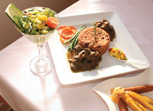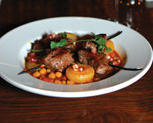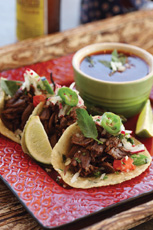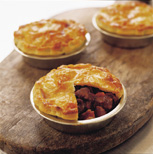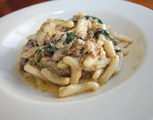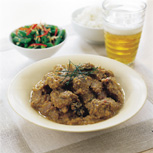


Carolyn Alburger
Get this: the most consumed meat in the world isn’t beef, chicken or pork – it’s goat. Here in America, goat cheese is the most widely consumed goat byproduct, with goat meat ranking a far-distant second. But in the past five years, the global popularity of goat meat has begun to spill over to California.
Known as Chevon in northern Europe, Capra or Capretto in Australia and Southern Europe, and Cabrito in Hispanic countries, goat meat has been consumed in most cultures since the advent of civilization. Here in the States, it has taken a backseat to mass-produced beef, pork, and chicken in recent decades.
“We have no culture of eating goat left,” says Chris Cosentino, Executive Chef of Incanto restaurant, acclaimed for its use of lesser-known meats in San Francisco. “Its pattern of decline has been similar to that of mutton.”
As infrastructure for goat production has decreased in the U.S., mass consumption has concurrently died out.
Goat on the rise
Over the past five years, however, chefs have started to turn to goat meat again. Jesse Perez, Executive Chef at Fuego at the Maya in Long Beach, CA, credits The Food Network and epicurean blogs along with the recent influx of more Latin concepts. “Latin cuisine has blown up in the last few years,” said Perez, “and goat is a Latin staple.”
Farmer Michael Panza, who farms goat for sale through his Bay Area-based Biagio Artisan Meats, said “Goat is a resilient, easy meat to grow. As more American consumers become open to it, I think we’re going to see more farmers experimenting with it.”
What’s so great about goat?
With 50 percent less fat than beef, 45 percent less fat than lamb, and 15 percent less fat than veal, goat meat provides a wonderful, rich flavor. Goat fat contains less saturated fat and higher levels of mono- and poly-unsaturated fat than other meats, causing it to generate more liquid fat drippings during and after the cooking process. All of these factors mean the meat has less cholesterol, making it a healthier choice as our collective concerns about obesity escalate.
Health and fat content aside, chefs love goat because of its flavor. “Goat meat takes on different flavor nuances throughout the cooking process,” remarks Keone Lewis, owner of Kingston Café in Pasadena, CA. Lewis has been serving traditional Jamaican-style curry goat since he opened his restaurant with his mother 15 years ago.
The importance of farming
“Until recently, the quality of goat meat in our country wasn’t the greatest,” Michael Panza of Biagio Artisan Meats in San Francisco remarks. “If farmers are raising goat for consumption, they need to make sure the animals are grazing on corn and grain for optimum flavor.”
For this reason, chefs using goat today know their source inside and out. They seek goats raised on a vegetarian diet, free of hormones and antibiotics.
“If the goat’s diet is controlled, it develops a sweet flavor that’s only a touch gamey,” says Chef Perez. “It’s almost like wild boar.”
Overcoming perception
“People who don’t like goat think the flavor is ‘barn-yardy,’” says Chris Cosentino, who has made a name for himself by introducing lesser-known meats and cuts to the dining public at his San Francisco restaurant, Incanto. “We instruct our servers to ask diners if they like the taste of strong goat cheese. If the answer is ‘yes,’ then it’s likely they’ll enjoy goat.”
“I’ve had very minimal problems with the flavor of goat once people try it,” said Perez. “The challenge is getting over that initial hurdle.”
Believing consumers will adapt to goat meat if they are eased into it properly, Perez also stresses the importance of testing the new meat on the kitchen and the service first. “Get them on board. Then you can put it out there to your customers.”
Making the strange familiar
Many professionals introduce goat to their clientele first as a special. For instance, Chef Perez will serve his goat in a taco on his “Oaxaca and her 7 moles” special dinner menu in January. “It will help break the ice and gauge general perception of goat before I put it on the regular menu.”
As a next step, Perez will place goat in a taco as an appetizer. “This puts the meat in a context customers are comfortable with so they are more willing to try it.”
Chris Cosentino echoes the importance of introducing the unfamiliar with the familiar. “One of my favorite preparations is a goat noodle soup. It’s a fun take on the classic chicken noodle soup most Americans grew up with.”
Chef Matthew Colgan, who cooked in Italy and at 42 Degrees in San Francisco before taking over as executive chef at the acclaimed À Côté in Oakland, first served goat on a special Spring Sardinian wine dinner menu paired with “bold, lusty” red wines that hold up to the distinct flavors of the meat.
When Colgan puts goat on his winter menu at À Côté, he plans to braise the leg and serve it as a stew with polenta. “Everyone loves polenta and braising will ensure the meat is tender and holds a great flavor.”
Favorite preparations
Though braising goat meat and presenting it in tacos and stews is the preferred way to introduce the meat, chefs are having fun using the whole goat in the kitchen.
Matthew Gandin, who has served as Executive Chef at San Francisco’s acclaimed Delfina restaurant for the past two years, sources the whole animal from Biagio. “I like to serve ‘goat three ways’ in order to max out the food cost and give the greatest perceived value to the customer. I’ll serve some braised leg next to some sliced loin and a few ribs. The presentation is delicate and exciting for people and it educates on the range of flavors goat meat assumes.”
Perez finds the goat rack very similar to New Zealand lamb in size and flavor. He likes to break the rack into ribs and prepare them as “pops” by quickly marinating, searing, and serving with something seasonal like rajas or sweet potato puree on the side.
Colgan loves serving the rack as well, though he keeps it in one piece, rubs it with herbs and then roasts it in the oven so it caramelizes.
If Cosentino had his druthers, he would serve goat offal and liver as much as possible. “I especially enjoy the intensity of these cuts. These are fun and flavorful meats to serve.”
Chefs like Cosentino are among a handful of our country’s foremost chefs who are starting the buzz about goat, with a helpful push from avant garde food TV and food writers. If you haven’t gotten your goat yet, now is a better time than any to be a trendsetter.
Carolyn Alburger has enjoyed creating in the kitchen since age nine, when she encountered the Frugal Gourmet and a very special peach custard crumb pie in the Better Homes and Gardens cookbook. A graduate of Tante Marie’s Professional Culinary Program, her work has been printed in outlets as diverse as Daily Candy, Elle a Table, the San Francisco Chronicle and the MintLife blog. Follow her on Twitter at @CarolynAlburger.
